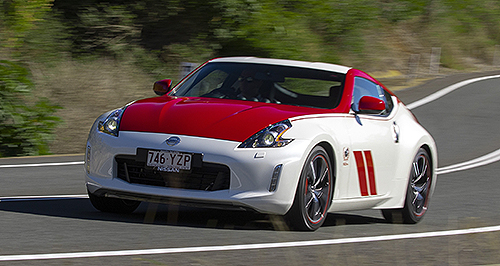Make / Model Search
News - NissanNissan trademarks new Z badge ready for new modelRetro: The new Z logo is almost identical to the 1969 original, perhaps hinting at some retro-inspired styling for the next-generation Z car. Nissan’s next-generation Z car is finally in the works, might not be too far off25 Mar 2020 NISSAN’S latest Z car has taken the next – admittedly small – step towards production with the Japanese brand filing a patent application for an updated Z logo with IP Australia this month.
Officially filed on March 6, the new logo is almost identical to the original Z badging that adorned the legendary Datsun 240Z way back in 1969, a clear homage to its 51-year-old forefather.
The new – and therefore classic logo – replaces the 350Z and 370Z’s blocky, straight-edged font style with a more classic flared style, with arguably the biggest change being the return of the oblique centre dash running through the middle of the letter.
Official details on the new Z are almost non-existent at this point in time, with Nissan Australia refusing to give anything away about the looming sportscar, even declining to comment on the refreshed Z logo.
“Unfortunately we cannot comment on future product or product plans,” a spokesperson told GoAuto.
This lack of any concrete information has led to the rumour mill going into overdrive in recent weeks with almost countless speculations revolving around the new car’s powertrain, name and styling arising, though a few key theories stand out from the rest and a few other possibilities can be drawn from the refreshed Z logo.
In terms of a powertrain, the most popular theory is that the new Z will be powered by the same twin-turbocharged 3.0-litre V6 petrol engine as the Infiniti Q50 sedan and Q60 coupe, which in its most potent guise produces 298kW of power and 475Nm of torque.
This theory holds water in more ways than one, with almost classic Z car displacement and cylinder count, Toyota Supra-rivalling power and torque with the added bonus that Infiniti is a subsidiary of Nissan, meaning the engine has already been developed and engineered in-house.
Traditionally Z cars have been named in accordance with their engine size – the original 240Z was powered by a 2.4-litre straight six which was then enlarged to 2.6-litres for the 260Z.
The following 280ZX sported a 2.8-litre straight six, both generations of the 300ZX boasted 3.0-litre V6s, the 350Z brandished a 3.5-litre V6 and the now decade-old 370Z is motivated by a 3.7-litre unit.
On this ruling – if the new car does sport the aforementioned 3.0-litre – then the new Z should in theory be dubbed the 300Z or even 300ZX, although the common consensus is the new car will be dubbed the 400Z as a reflection of its horsepower figure (298kW/400hp) and it being the next step in Z car lineage.
According to American outlet Autoblog, designers have been looking to the past for inspiration with the new model reportedly set to brandish a 240Z style front end, Z32 300ZX inspired tail-lights and a 370Z-esque silhouette.
“They’re going back to the roots of the car,” a source said.
Confirmation of a new Z car was first made in October last year by Nissan Motor Company head of product planning Ivan Espinosa at the Tokyo motor show where he also confirmed plans for a new GT-R supercar.
“Of course, these two cars are at the heart of Nissan,” he said. “And we are actively looking at working at that now,” he said at the time.
“So, you can expect that we will come up with something on this sometime soon.”
No timeframe for the new car has been revealed.
The Z car lineage was first kicked off in 1969 by the iconic 240Z, one of the first genuinely affordable sportscars in the world.
In 1974 it was replaced by the more powerful 260Z which was available either as a genuine two-seater (like the 240Z) or as a longer 2+2 model which added 302mm to the wheelbase.
Four years later, the 260Z was replaced locally by the 280ZX which shifted the Z car lineage away from being dedicated sportscars and onto being more comfortable grand tourers, as proven by the bigger and heavier Z31 300ZX which followed in 1984.
The 300ZX was not only bigger, heavier and to start with at least slower than its predecessor, but it also did away with the L-series straight six-cylinder engine, replacing it with a 3.0-litre V6.
A turbo variant landed in 1986, just three years before the almost all-new Z32 300ZX arrived in 1989.
Australia missed out on the fire-breathing twin-turbo model sold in other markets, forced to make do with a new naturally aspirated 3.0-litre V6 until it went out of production in 1996, replaced by the 350Z in 2003.
The 350Z was available to a variety of different trim levels and treated to almost as many model updates over its six-year life, replaced in 2009 by the current 370Z.  Read more24th of October 2019  Nissan confirms Nissan 370Z, GT-R replacements370Z, GT-R successors in works, could be shared BMW/Toyota style and even be EVs23rd of August 2019  Driven: Nissan celebrates Z’s 50th anniversaryLimited-edition 370Z enters showrooms to mark 50 years of Nissan Z sportscars |
Click to shareNissan articlesResearch Nissan Motor industry news |











Facebook Twitter Instagram